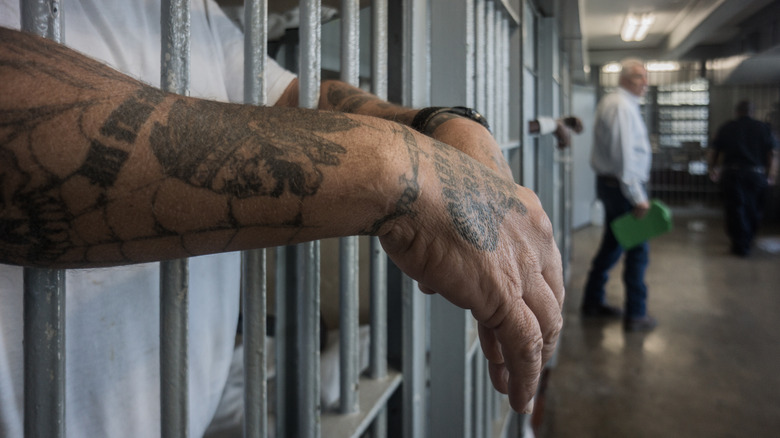Here's How Prisoners Actually Get Tattoos
Prisoners: They're generally pretty tatted up, right? Maybe they've got tattoos climbing the temples and crossing over the forehead. Maybe they've got something more tastefully done on the chest, arm, back, etc. Maybe the tattoos actually look pretty swank. But in all cases, the question begs: How do all these people actually get tattoos in prison? There aren't any tattoo parlors on prison grounds mixed in with work rehab programs, libraries, and yards full of jacked dudes using slabs of concrete for barbells or whatever.
Well, as you might not be too surprised to learn: Humans can get pretty inventive, especially when pressed and left with minimal options. Ultimately, what do we need to inscribe tattoos? We need a fluid that can be subdermally injected, but only a couple of millimeters deep. We also need a needle contraption that can poke the fluid under the skin, and it doesn't really need to be electric — look at the New Zealand Maori's traditional hammer-and-stick method, Tā moko. Beyond that, you just need to make sure the wound doesn't get infected.
As prison insider Leon Kingsley (not his real name) described on Business Insider in 2012, prisoners could start with a straightened-out and sharpened spring from a stapler threaded through a pen casing and hook it up to a motor from something like a CD player, which back then was sold in the commissary. The ink, meanwhile, can come from some ingenious chemistry that uses boot polish, baby oil, and a wick to get soot, which can then be mixed with water to make ink. This method, though, is just one of many.
A critical part of life behind bars
Before proceeding further, discard any ideas you have of regimented, standardized, and mutually agreed-upon procedures that prisoners use to ink each other. Inmates make it up as they go along, and methods and materials vary from place to place, time to time, and circumstance to circumstance. Suffice it to say — and this is the key takeaway here — the ubiquity of prison tattoos illustrates precisely how important they are to inmates, their senses of self, and the cultures that crop up behind bars. What else but art could prove so critical to expression and rehabilitation?
Convicted murderer Chris Dankovich at Thumb Corr Facility articulates on Prison Writers — a website featuring stories written by inmates – "The art of tattooing is a pillar of the underground economy and an understanding of prison tattoos an important part of surviving prison. Done in secret, with breaks to hide from the staff, they are then displayed proudly by those with them." Tattoos are also a way to demonstrate one's background, family ties, and beliefs. And importantly, Dankovich implicitly points out that there's no one master tattooist behind bars. He's gotten tattoos, he says, same as he's done them for others.
Another imprisoned person, Dan Grote, told The Marshall Project that motivations for getting tattoos vary, but include bare-bones defiance, "Not too different from in the world." He also says that getting tattoos is a way of "saying thank you" for the support received by other inmates.
Inventive engineering at its finest
Looking back to our original example from Leon Kingsley on Business Insider, Kingsley detailed one way make a tattoo gun and ink. As we mentioned, you start with a stapler spring from a stapler somewhere, straighten it out, and lengthen it using heat. Alternatively, you can use the spring from a combination lock. Then, you use sandpaper to make the needle sharper (remember those work rehab programs?). Finally, you put the needle in an emptied ballpoint pen and attach it to some kind of rotary motor.
For the ink, you fill a can of boot polish with baby oil and stick a wick inside. In the absence of fire, the oil chemically burns the wick and produces soot. This soot gets scraped off, blotted, and carefully placed into the opening of an empty toothpaste tube. Then, water gets added. Voila: instant ink. Okay, not too instant. At this point, prison inmates sound more clever than certified mechanical engineers. Then again, some of them might be certified mechanical engineers.
The Marshall Project adds that motors from beard trimmers make a good choice to power your DIY tattoo gun, and guitar strings can be manipulated into needles. It also describes trapping burning Bible pages and plastic razors under an empty milk carton to make soot. Any colored ink can come from family members sending arts and crafts packages.
Disease, discipline, vocation
For the U.S. prison system, tattoos behind bars remain not only illegal but health hazards. We say "most," because as former prison recreation therapist Manny Vargas told The Marshall Project, tattoos don't rank highly on the list of prohibited things behind bars, not in comparison to drugs or firearms — "pick your poison," he says. Some facilities like the Bath Institution in Ontario, Canada actually opened a tattoo parlor inside in 2005 (which was too expensive to maintain), but they did in order to regulate the spread of diseases via used needles, infections, etc., per The New York Times. Inmates there could just roll inside to get their tattoos. The Minnesota Department of Corrections has gone one clever step further and just made tattoo artistry part of its vocational programs at Stillwater Correctional Facility.
But for the vast majority of the world's imprisoned people, getting a prison tattoo is not such an easy task, no matter how honed the methods. Guards prowl hallways and grounds and watch for illegal behavior. And no matter Leon Kingsley's assertion on Business Insider that infections are rare, they do happen. This is why the New York Department of Corrections says that bans on tattoos exist to "preserve the health of incarcerated individuals and staff, as well as the security of the facility," per The Marshall Project. Correctional Nurse says that problems boil down to a lack of sterilized needles, and the subsequent spread of HIV, Hepatitis B, and Hepatitis C.



